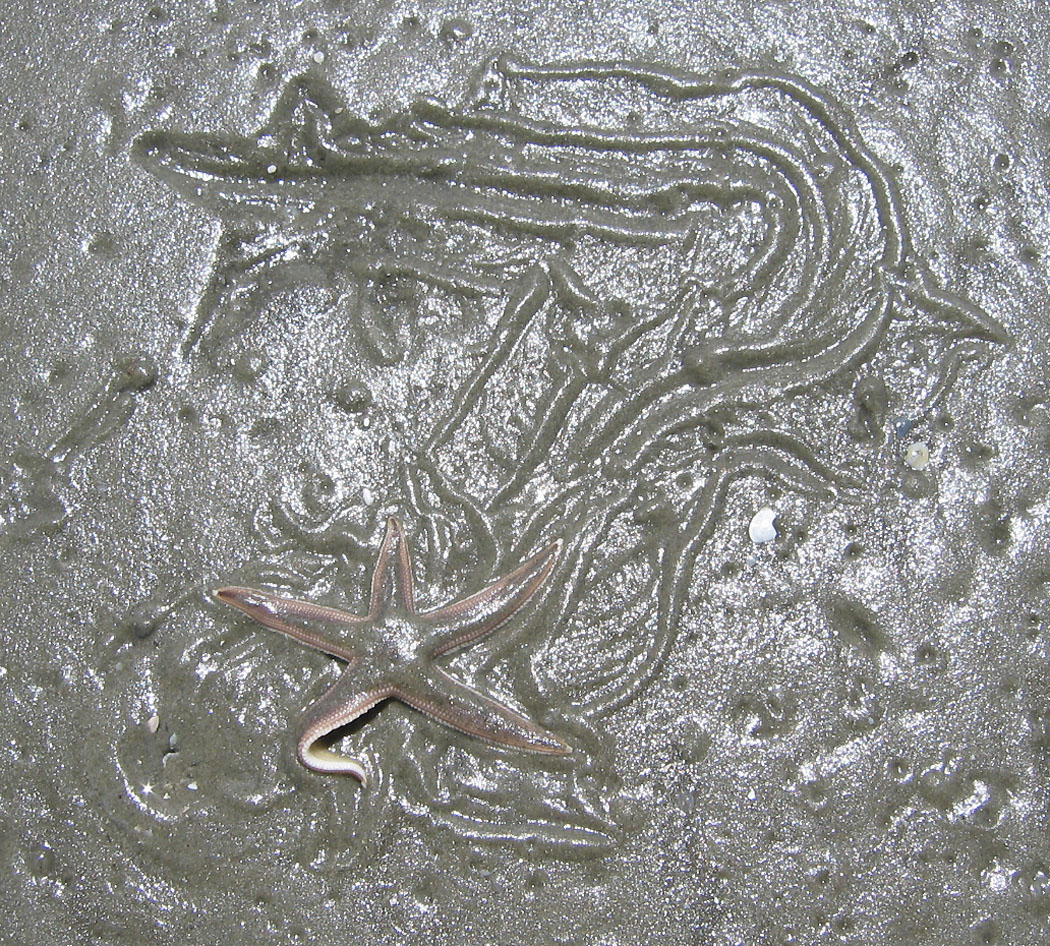Think of a crinoid, and you will likely visualize one of these gorgeous echinoderms looking like a colorful, delicate flower on a brightly lit seafloor, aptly justifying its nickname as a “sea lily.” Take your crinoidal fantasy just a bit further, and imagine its fine, feathery arms gently waving in harmony with ocean currents passing through them, its stalk bending with each current, but otherwise staying firmly attached to a sea bottom. If you know a little more about crinoids, though, you might also think of one without a stalk – a “feather star” – swimming above the ocean floor, performing an aquatic dance reminiscent of the Hindu Mother Goddess Durga.
A swimming stalkless crinoid (“feather star”) at the Tanjung Papaya dive site, Mandado Bay, Indonesia, recorded by Pim Van Schendel in October 2015. Notice how its barely touches the sandy bottom, leaving few clues of its behavior in the sediments below.
You might also let your dreams go back to the ancient past, when crinoid “meadows” blanketed shallow-marine environments throughout the world, starting about 450 million years ago in the Ordovician Period and continuing through the Paleozoic Era. By the Carboniferous Period, crinoids were so abundant that their body parts contributed to limestones we now use for buildings. Following the mass extinction at the end of the Paleozoic, crinoids became more rare, but several lineages persisted through a few more mass extinctions, including the living ones that delight us today.
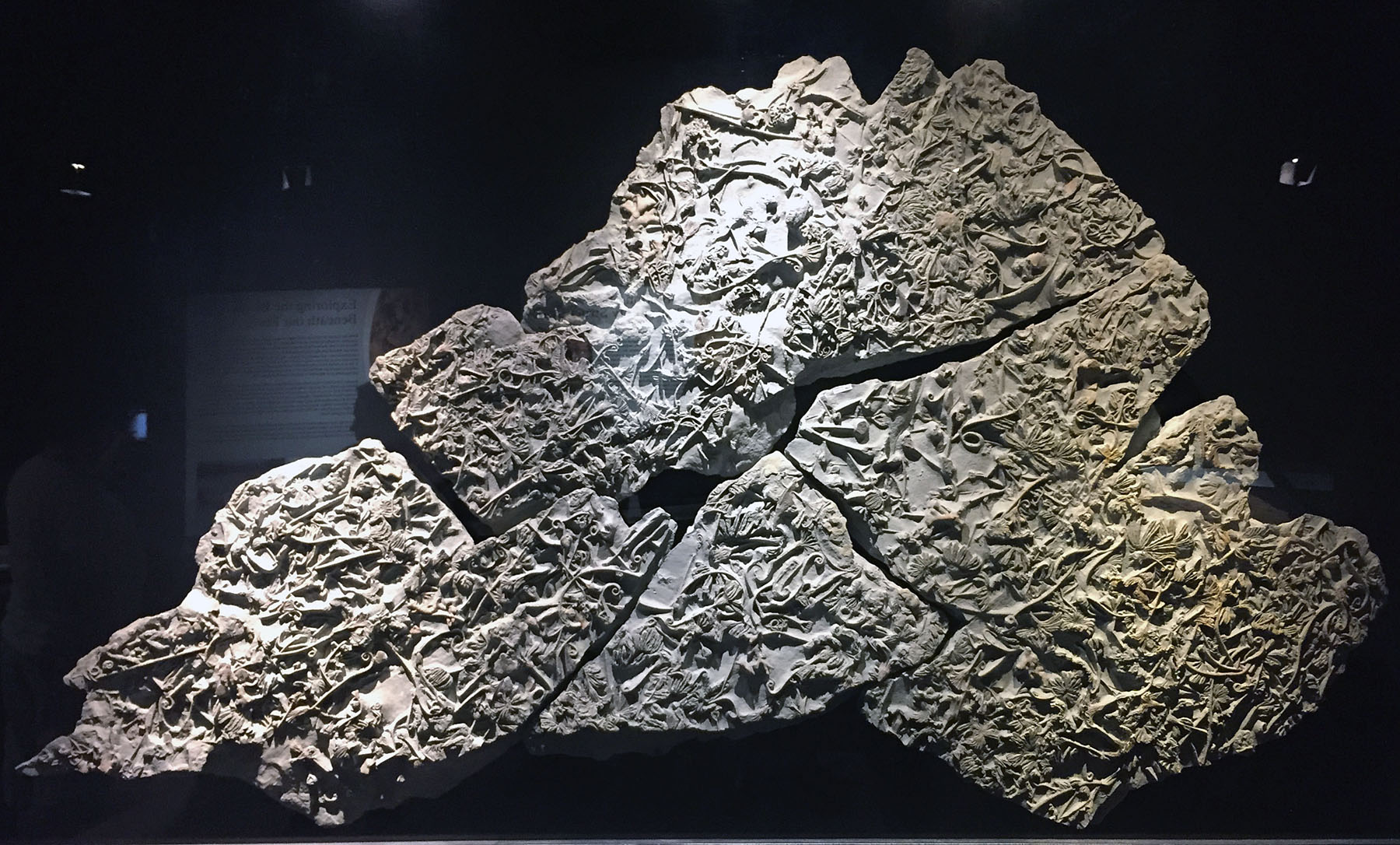 An Ordovician crinoid “meadow,” buried by a tropical storm about 440 million years ago. Slab is about 2 m (6.6 ft) wide, and more than a hundred exquisitely preserved are preserved on it. Specimen is at the Cincinnati Museum Center (Cincinnati, Ohio), and was discovered, recovered, and donated by Dan Cooper of The Dry Dredgers fossil club to the museum. (Photograph by Anthony Martin.)
An Ordovician crinoid “meadow,” buried by a tropical storm about 440 million years ago. Slab is about 2 m (6.6 ft) wide, and more than a hundred exquisitely preserved are preserved on it. Specimen is at the Cincinnati Museum Center (Cincinnati, Ohio), and was discovered, recovered, and donated by Dan Cooper of The Dry Dredgers fossil club to the museum. (Photograph by Anthony Martin.)
Now, instead of such idyllic reveries, think of a crinoid experiencing a slow, agonizing death. Imagine it imitating the clichéd image of a man crawling through a desert and croaking the word “water” as it pulls itself along a barren and air-filled landscape, searching for a comforting sea. If this is not a jarring enough of a picture for you, don’t worry, it gets worse. The crinoid doesn’t quite make it to the sea, and when it can’t move any further, it tries in vain to attach itself to the land beneath it. Minutes later, it dies. A few hours pass before it is finally submerged (too late) by the next high tide, its body put to rest under a blanket of sediments.
The real twist to this story, though, is how 170 million years later, some upright bipedal primates – at least a few of whom were quite fond of crinoids – spotted this one on a ground surface in the middle of present-day Portugal, still connected to its last trail of life.
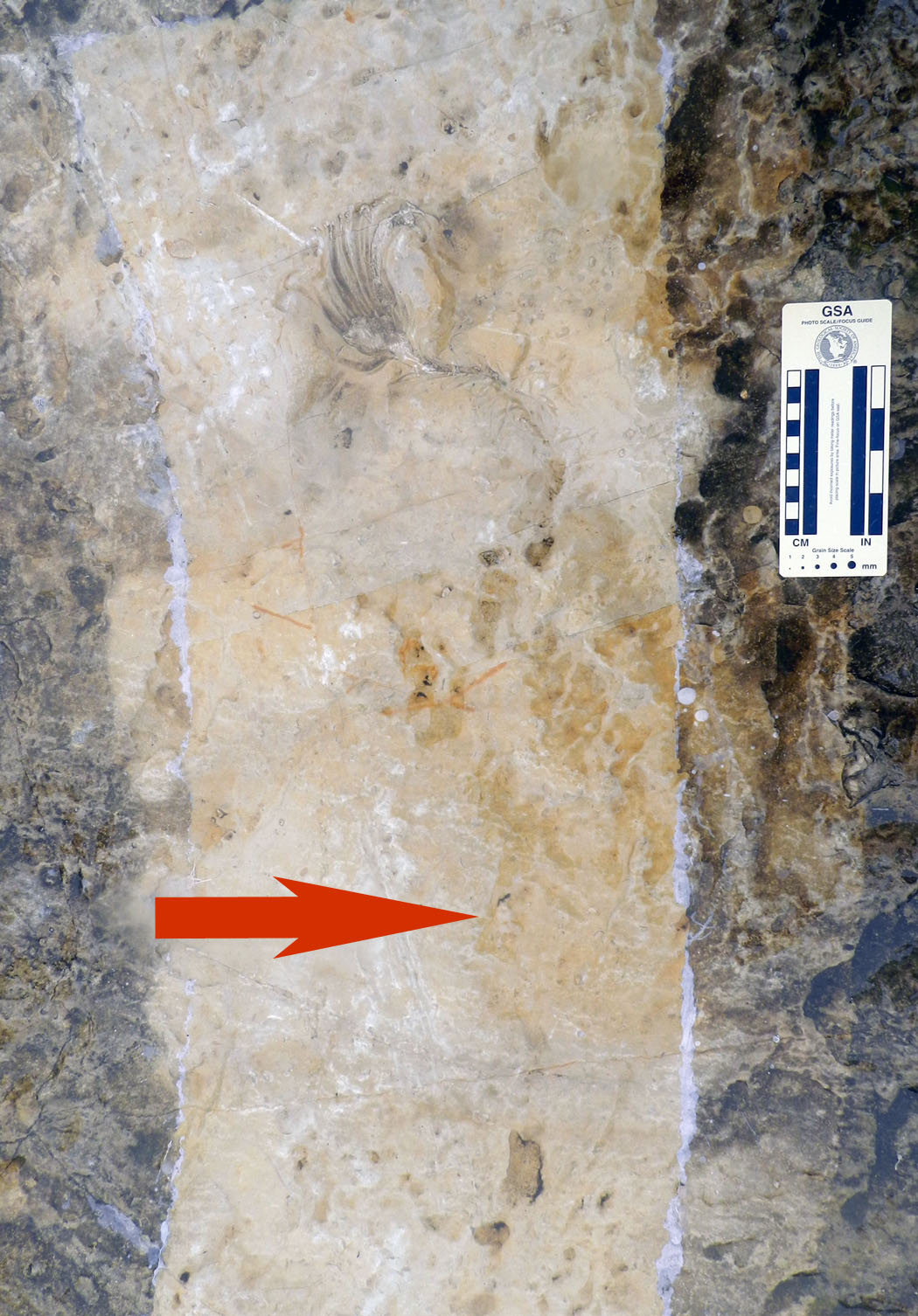
The only known trace fossil of a crawling crinoid in the geologic record in a limestone bed of the Chãi des Pias Formation (Middle Jurassic, about 170 mya) near São Bento, Portugal. The red arrow points to the trail, evident here as a shallow, meandering, and slightly darker groove. How do we know a crinoid made it? Because it ends with a crinoid. Its last three decisions were to move to the right, then to the left, and stop forever. (Photograph by Anthony Martin.)
I was lucky enough to see the only known trace fossil of a crawling crinoid and the crinoid that made it during a paleontological field trip last month in Portugal. The trip was connected to the International Ichnological Congress, a once-every-four-year meeting simply known as Ichnia. The field-trip stop with the crinoid and its trail was at a relatively modest outcrop of Middle Jurassic limestone near the Portuguese parish of São Bento (Porto de Mós municipality).
Despite constant rain that day and the small area exposed at the field site, its trace and body fossils grabbed our attention, then held us as willing captives for more than an hour. Among the ichnological treats offered by this Jurassic tidal-flat deposit were crab trackways – including what might be the longest invertebrate trackway in the geologic record – long snail trails, crustacean burrows, fish trails, and much more. For those people who love body fossils, and especially of echinoderms, the rock also held beautifully preserved sea stars and spiny sea urchins. It was marvelous, and for days afterwards, all of the trip participants talked about this place and its bounty.
Given such fossil riches, it is tempting for me to share them all with you here. Nonetheless, I will instead focus on the star: not a sea star, but a relative. Despite the rain, its trail was easy to spot, as it was located inside of a white-yellow strip on the surface of an otherwise dull-gray limestone. The area surrounding the trace fossil had been inadvertently brightened by the researchers studying it. When they made a latex mold of the trace fossil, the latex took some of the weathered surface with it. From my perspective, it looked like a landing strip. Which, in a sense, it was.
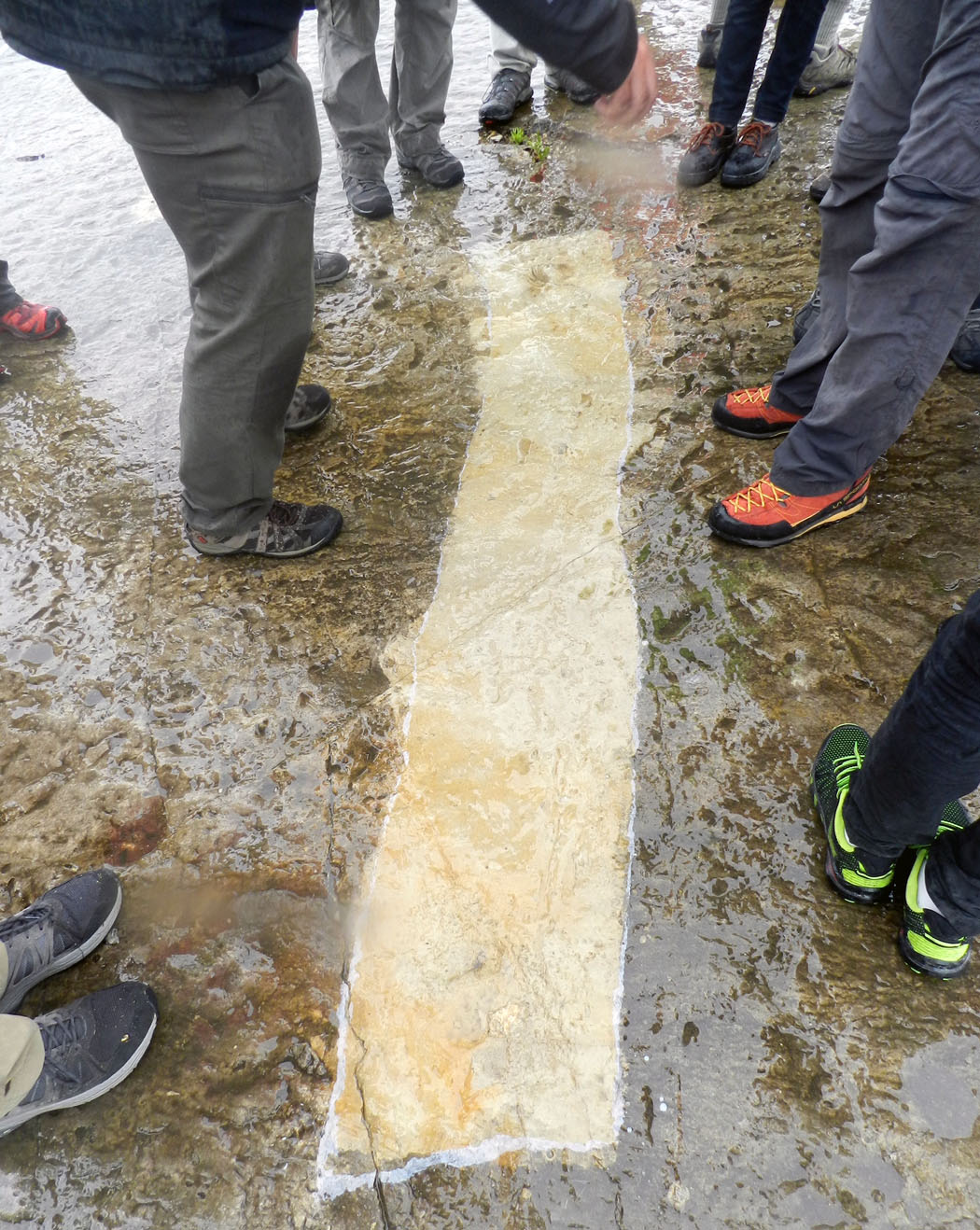 Crinoid coming in for a landing, the hard way. The bright area marks where paleontologists made a latex mold of the crinoid trail, but also. shows how it crawled for more than 2 m (6.6 ft) along the tidal-flat surface. The crinoid is at the far end of the strip. Based on all of the paired shoes with people wearing, one might conclude that the rain was doing a poor job of dampening our enthusiasm. (Photograph by Anthony Martin.)
Crinoid coming in for a landing, the hard way. The bright area marks where paleontologists made a latex mold of the crinoid trail, but also. shows how it crawled for more than 2 m (6.6 ft) along the tidal-flat surface. The crinoid is at the far end of the strip. Based on all of the paired shoes with people wearing, one might conclude that the rain was doing a poor job of dampening our enthusiasm. (Photograph by Anthony Martin.)
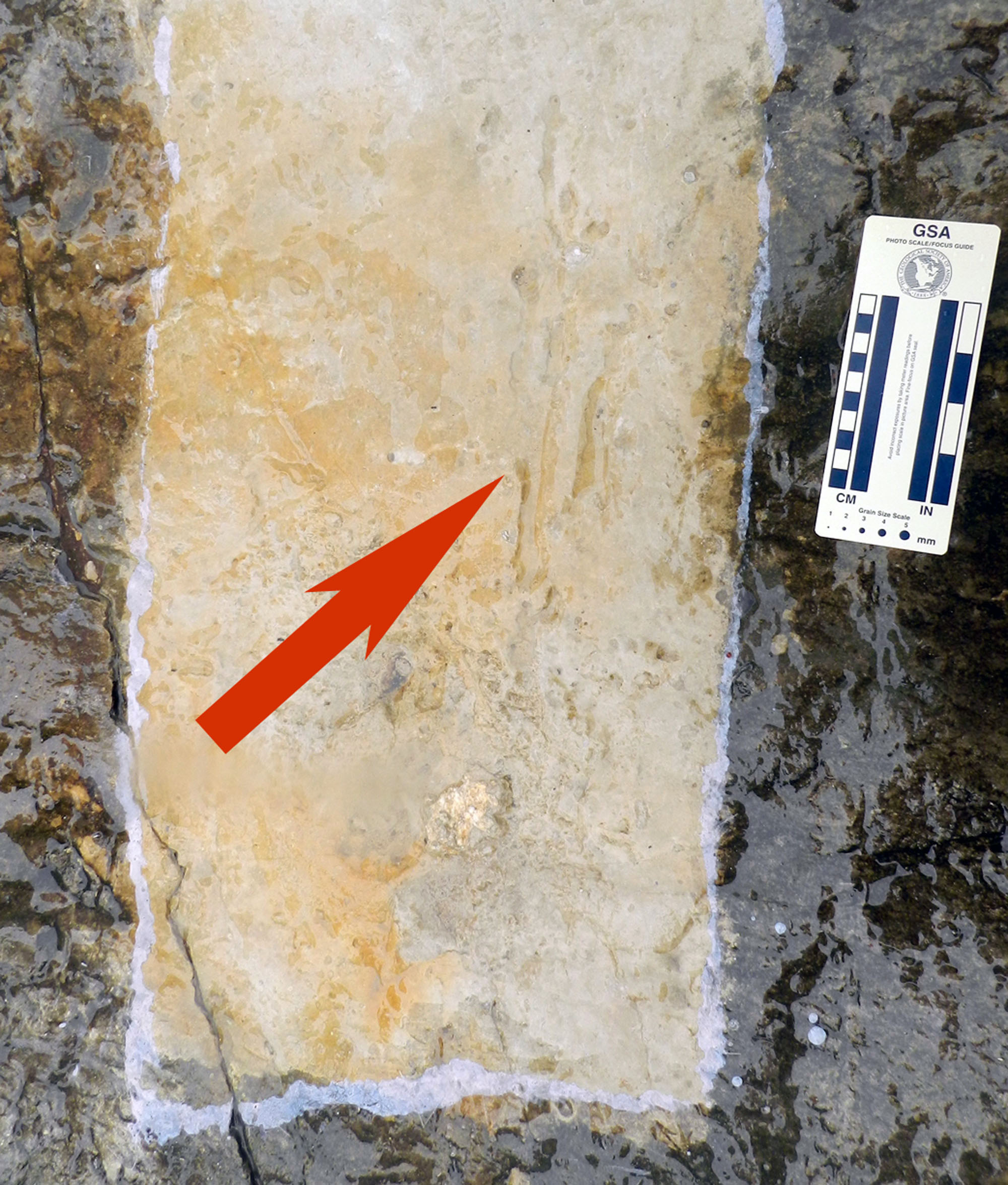 A close-up of the first part of the crinoid trail. Once stranded on the tidal flat, it began dragging itself across the originally soft sediments, leaving a groove from its stalk and impressions from its arms (arrow). Scale has centimeters on the left and inches on the right. (Photograph by Anthony Martin.)
A close-up of the first part of the crinoid trail. Once stranded on the tidal flat, it began dragging itself across the originally soft sediments, leaving a groove from its stalk and impressions from its arms (arrow). Scale has centimeters on the left and inches on the right. (Photograph by Anthony Martin.)
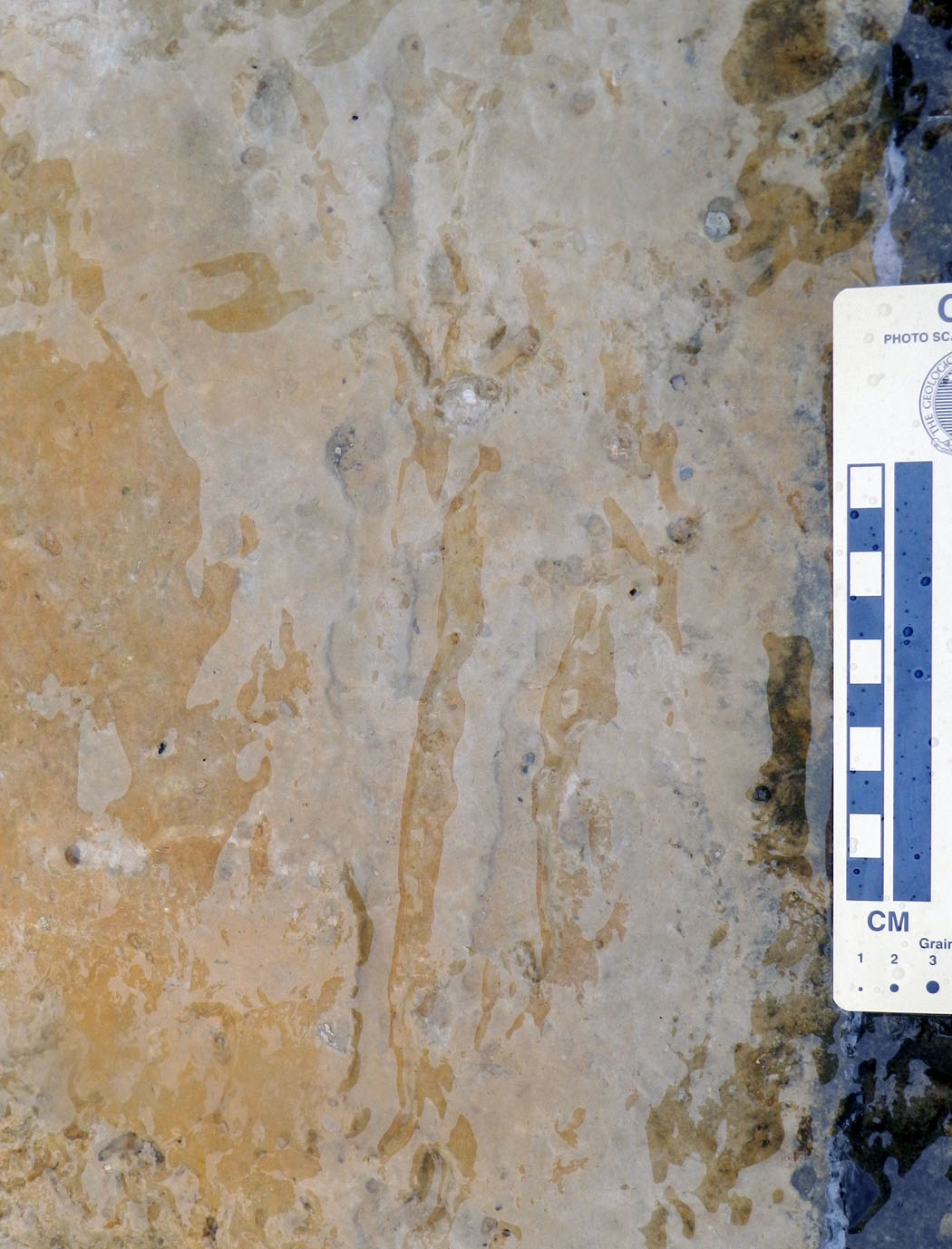 Although this fossilized crinoid trail is underwater here, it wasn’t when the crinoid made it. Exposed on the tidal flat, it tried to get back to the sea by pulling itself forward with its arms, its stalk dragging behind it. Its arms left a wake of disturbance on either side of a thinner central groove from its stalk. (Photograph by Anthony Martin.)
Although this fossilized crinoid trail is underwater here, it wasn’t when the crinoid made it. Exposed on the tidal flat, it tried to get back to the sea by pulling itself forward with its arms, its stalk dragging behind it. Its arms left a wake of disturbance on either side of a thinner central groove from its stalk. (Photograph by Anthony Martin.)
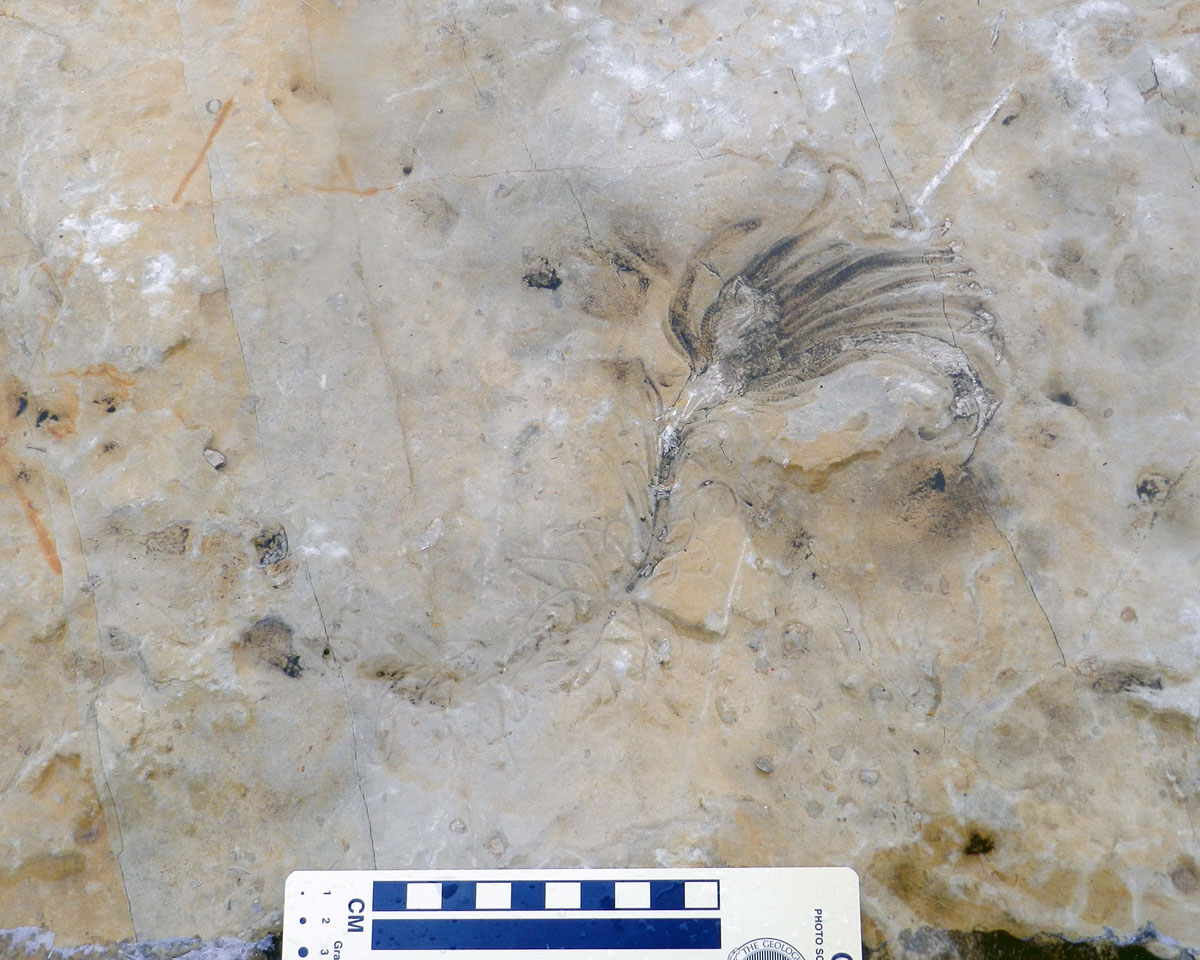 The end of the trail, which was not a happy one for the crinoid, but ultimately a fulfilling one for paleontologists and ichnologists. (Photograph by Anthony Martin.)
The end of the trail, which was not a happy one for the crinoid, but ultimately a fulfilling one for paleontologists and ichnologists. (Photograph by Anthony Martin.)
Trace fossils that represent the last moments of an animal’s life – corroborated by a direct association of the animal with its trace – are rare, but known. Such traces, whether modern or fossil, are called mortichnia (mort = “death” and ichnia = “traces”), and this trail with its crinoid maker definitely qualifies as one. Based on this trace fossil and many other geological clues at the outcrop, it was on what was originally a tidal flat, an environment well outside of a crinoid’s comfort zone. It may have been happily filter-feeding offshore, but was uprooted by waves and washed up by a high tide.
Because this is a Jurassic crinoid, you might wonder (as I did) if any modern stalked crinoids can crawl like this, using their arms to drag themselves along a sedimentary surface. The answer is yes, they can. But this is easier for a crinoid to do when underwater, where it is more buoyant. As far as I know, no one has experimented with modern stalked crinoids to see whether they can do this on land, let alone documented any of these animals getting dumped onto a tidal flat and then trying to make it back home.
Footage of a crawling stalked crinoid, albeit one underwater. This one was observed in about 400 m (1,300 ft) deep water off Little Bahama Bank, as reported by Baumiller and Messing (2007). For a detailed analysis of its movement and the traces that would result from this, read their article here.
Although the species of crinoid that made its death crawl is not yet identified, the researchers who studied it concluded it is an isocrinoid. Paleontologists who have studied stalked crinoids figured that the first ones capable of crawling may not have evolved until the Devonian Period, about 350-400 million years ago. Until then, they were sedentary. What changed, giving crinoids good reason to get up and walk away? Probably predation. Predators, which likely included fish but also other echinoderms, must have found crinoids easy and tasty targets, which would have favorably selected for more mobile forms. As Eddie Vedder might say, it’s evolution, baby.
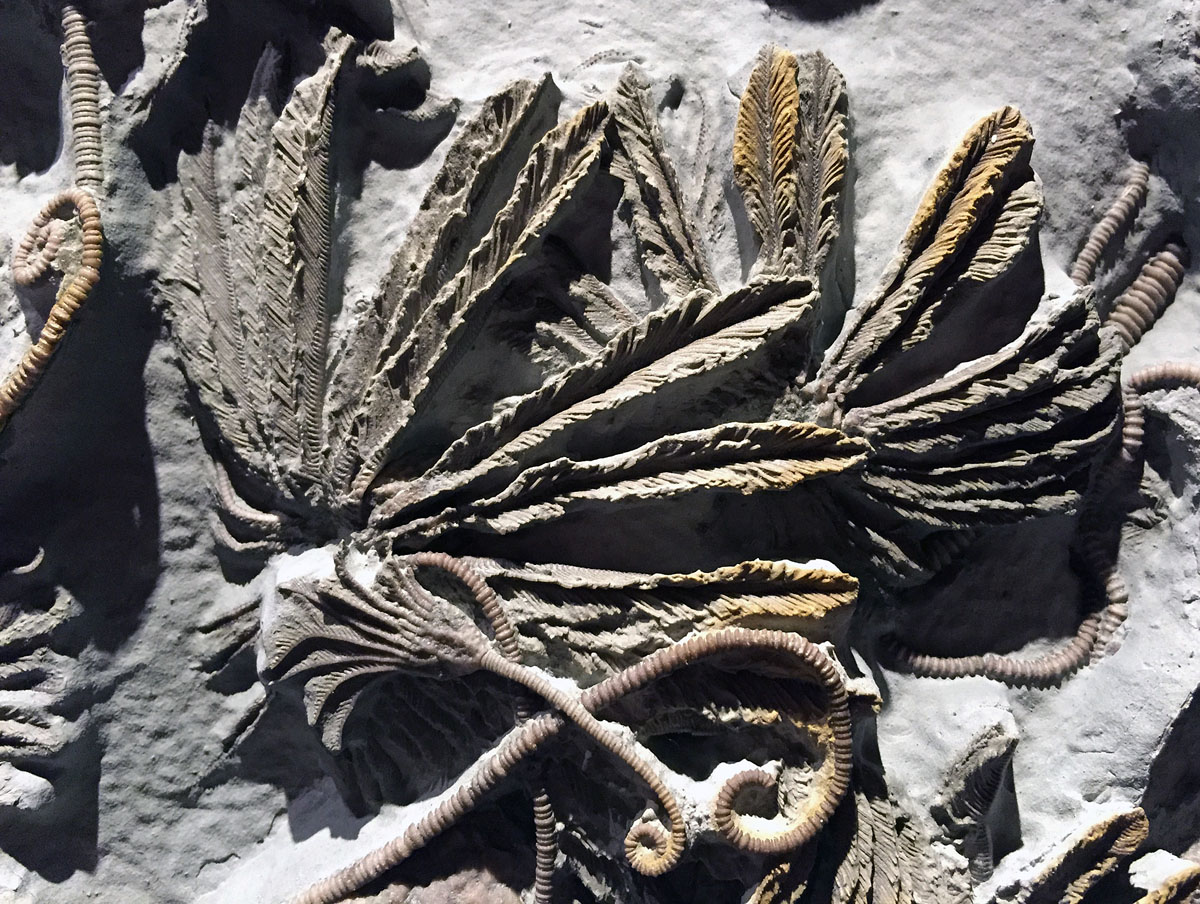 Once Ordovician crinoids settled down, they had no place to go. (Photograph by Anthony Martin, taken at the Cincinnati Museum Center.)
Once Ordovician crinoids settled down, they had no place to go. (Photograph by Anthony Martin, taken at the Cincinnati Museum Center.)
I won’t go through all the details of the report on this crinoid and the other extraordinary trace and body fossils at this site in Portugal. For that, you can read the original research article by Carlos Neto de Carvalho – who was also one of the field-trip leaders – and his colleagues, published earlier this year. All of them deserve to be famous for this extraordinary discovery, and I and my colleagues who were there all felt privileged to have seen it for ourselves, 170 million years after a crinoid went on its final journey.
Many thanks (muito obrigado) to Carlos Neto de Carvalho and Joana Rodrigues for organizing and leading such memorable field trips before and after Ichnia 2016, giving us all an appreciation for the wonderful paleontology and culture of Portugal. For more information, photos, and videos about stalked crinoids, check out Christopher Mah’s excellent post Stalked Crinoid Roundup! and other crinoid-related posts at his appropriately named blog, Echinoblog.)
References
Baumiller, T.K., and Messing, C. 2007. Stalked crinoid locomotion, and its ecological and evolutionary implications. Palaeontologia Electronica, 10, 2A. (PDF of open-access article here.)
Neto de Carvalho, C., Pereira, B., Klompmaker, A., Baucon, A., Moita, J.A., Pereira, P., Machado, S., Belo, J., Carvalho, J., and Mergulhão. 2016. Running crabs, walking crinoids, grazing gastropods” behavioral diversity and evolutionary implications of the Cabeço da Laderia Lagerstätte (Middle Jurassic, Portugal). Communicações Geológicas 103, Especial 1, 39-54. (PDF of open-acccess article here.)

